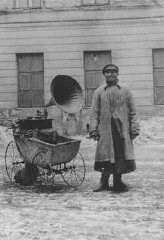
Photo
Browse an alphabetical list of photographs. These historical images portray people, places, and events before, during, and after World War II and the Holocaust.
<< Previous | Displaying results 1801-1850 of 2616 for "Photo" | Next >>
-
Portrait of members of a Hungarian Jewish family
PhotoPortrait of members of a Hungarian Jewish family. They were deported to and killed in Auschwitz soon after this photo was taken. Kapuvar, Hungary, June 8, 1944.
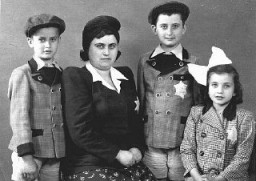
-
Portrait of members of the Freemasons Lodge of Chernovtsy, Bukovina
PhotoGroup portrait of members of the Freemasons Lodge of Chernovtsy, Bukovina, approximately 75 percent of whom were Jewish. The members were mainly intellectuals and leaders in business and local government. Among those pictured are Dr. Max Ennis (top row, third from the left); pharmacist, Dr. Abraham Guttman (top row, far right); an official in the revenue service, Dr. Max Gottfried (second row from the top, sixth from the left); and the judge, Dr. Jacob Rubel (third row from the top, far left). Chernovtsy,…
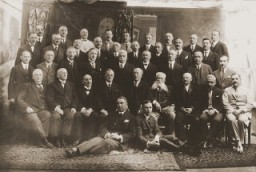
-
Portrait of Mordechai Mishulam
PhotoPortrait of Mordechai Mishulam. He was a dealer of second-hand items. He lived at Zmayeva 23 in Bitola. This photograph was one of the individual and family portraits of members of the Jewish community of Bitola, Macedonia, used by Bulgarian occupation authorities to register the Jewish population prior to its deportation in March 1943.
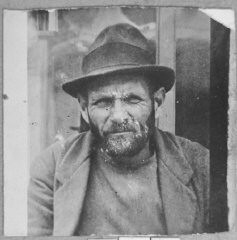
-
Portrait of Norman Salsitz's family
PhotoIn this 1934 portrait of Norman Salsitz's family, Norman is seated in the front row (at left). In the top row, center, an image of one of Norman's brothers has been pasted into the photograph. This is seen by comparing the size of the brother's face with the others pictured. Pasting in images of family members who could not be present during family portraits was common practice and in some cases the resulting composite images are the only remaining visual records of family groups.

-
Portrait of Palomba Kalderon
PhotoPortrait of Palomba Kalderon, daughter of Mushon Kalderon. She was a student and lived at Dalmatinska 65 in Bitola. This photograph was one of the individual and family portraits of members of the Jewish community of Bitola, Macedonia, used by Bulgarian occupation authorities to register the Jewish population prior to its deportation in March 1943.
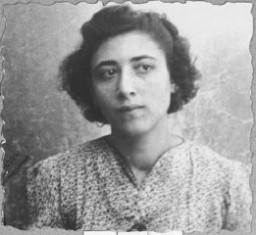
-
Portrait of Rabbi S. Djain
PhotoPortrait of Rabbi S. Djain, taken in Bitola. This photograph was one of the individual and family portraits of members of the Jewish community of Bitola, Macedonia, used by Bulgarian occupation authorities to register the Jewish population prior to its deportation in March 1943.
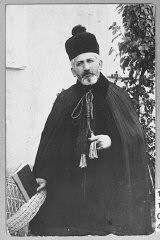
-
Portrait of Rabbi Shimon Huberband
PhotoPortrait of Rabbi Shimon Hoberband, who was involved in the activities of Emanuel Ringelblum's Oneg Shabbat archives in the Warsaw ghetto.
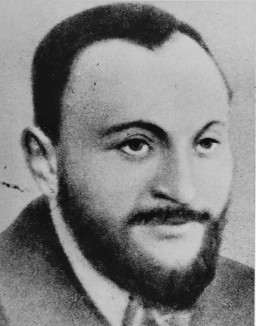
-
Portrait of Reinhard Heydrich
PhotoReinhard Heydrich, chief of the SD (Security Service) and Nazi governor of Bohemia and Moravia. Place uncertain, 1942.
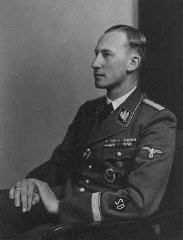
-
Portrait of Sara Ischach
PhotoPortrait of Sara Ischach, wife of Lazar Ischach. She lived at Drinksa 77 in Bitola. This photograph was one of the individual and family portraits of members of the Jewish community of Bitola, Macedonia, used by Bulgarian occupation authorities to register the Jewish population prior to its deportation in March 1943.
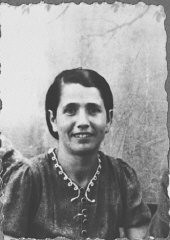
-
Portrait of Sara Israel
PhotoPortrait of Sara Israel, wife of Isak Israel. She lived at Krstitsa 10 in Bitola. This photograph was one of the individual and family portraits of members of the Jewish community of Bitola, Macedonia, used by Bulgarian occupation authorities to register the Jewish population prior to its deportation in March 1943.
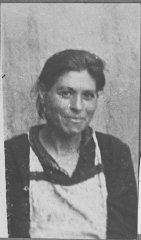
-
Portrait of Sigmund Freud
PhotoPortrait of Sigmund Freud. Freud's writings were burned during the 1933 book burnings.

-
Portrait of Solomon Kalderon
PhotoPortrait of Solomon Kalderon, son of Bohor Kalderon. He was a tailor and lived at Karagoryeva 67 in Bitola. This photograph was one of the individual and family portraits of members of the Jewish community of Bitola, Macedonia, used by Bulgarian occupation authorities to register the Jewish population prior to its deportation in March 1943.
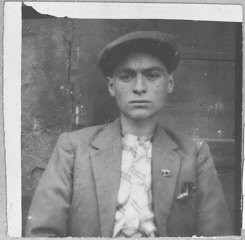
-

-
Portrait of the family of Bohor Kalderon
PhotoPortrait of the family of Bohor Kalderon. This photograph was one of the individual and family portraits of members of the Jewish community of Bitola, Macedonia, used by Bulgarian occupation authorities to register the Jewish population prior to its deportation in March 1943.

-
Portrait of the Katz Family
PhotoGroup portrait of members of the Katz family of Munkacs. Pictured in the top row from left to right are: Chicha, Isabella, Philip, Jolon (Cipi), and Regina. In the bottom row are Helen (left) and Tereza. Munkacs, 1942–1943.
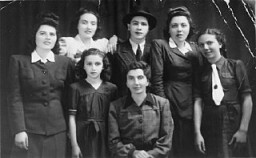
-
Portrait of the Menaker family in Lwów, Poland, circa 1922
PhotoThis portrait from around 1922 depicts three generations of the Menaker family. The hairstyles and clothing highlight the process of acculturation–adapting to and even adopting elements of the dominant, non-Jewish culture–in one Jewish family in the Lwów region. The older female relative wears a wig and a dress with long sleeves and a high collar. Orthodox Jewish women traditionally wore modest clothing and covered their hair with wigs or kerchiefs. By contrast, Szprinca (center) wears a dress with…
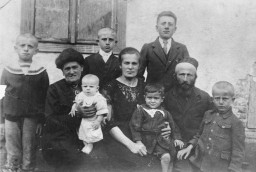
-
Portrait of the Rosenblat family in interwar Poland
PhotoPortrait of the Rosenblat family in interwar Poland. Photographed are: (back row from left to right) Elya, Jozef (father), and Itzik Rosenblat. Sitting from left to right are: Herschel, Deena (wife of Elya), Hannah (mother), and Taube Rosenblat (wife of Itzik). In 1941, a mobile killing unit killed Herschel in Slonim, Poland. Of the others, only Itzik and Deena survived deportation from the ghetto in Radom, Poland.
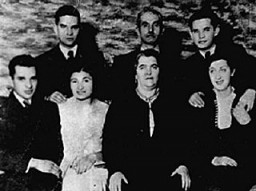
-
Portrait of the Shiber family in Lwów, Poland, 1935
PhotoThis 1935 portrait shows Samuel and Adela Shiber with three of their children—Salomon (left), Matylda (center), and Emanuel (right). The Shibers were a Jewish family from Lwów. Samuel owned a textile workshop in the city. Samuel and Adela spoke Yiddish at home, while the children spoke Polish among themselves. In this photo, there are no obvious markers of Jewish identity. The family wears clothing typical for middle or upper class families at the time. The children are dressed like most schoolchildren…
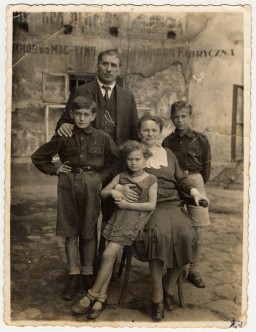
-
Portrait of the Weidenfeld family wearing Jewish badges in the Czernowitz ghetto
PhotoPortrait of the Weidenfeld family wearing Jewish badges in the Czernowitz (Cernauti) ghetto shortly before their deportation to Transnistria. Pictured from left to right are Yetty, Meshulem-Ber, Sallie, and Simche Weidenfeld. Cernauti, Romania, October 1941.
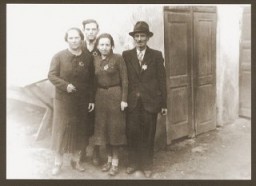
-
Portrait of three-year-old Estera Horn
PhotoPortrait of three-year-old Estera Horn wrapped in a fur coat. Chelm, Poland, ca. 1940. Estera was born in January 1937. Her father was killed soon after the Germans invaded Poland. Estera and her mother, Perla Horn, were forced into the ghetto in Chelm. At the end of 1942, during the liquidation of the ghetto, Perla and Estera escaped from the ghetto. They hid in nearby villages. In late 1943, Perla asked a family in Plawnice to take care of Estera. Perla tried to hide with a group of Jews in the nearby…
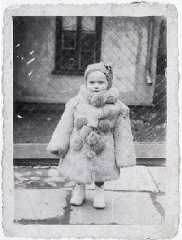
-
Portrait of Tosia Altman
PhotoPortrait of Tosia Altman (1918-1943), Jewish youth leader and member of the Jewish underground in the Warsaw ghetto.

-
Portrait of Tsewie Herschel taken while he was living in hiding
PhotoPortrait of Tsewie Herschel seated in a chair, taken while he was living in hiding. Oosterbeek, the Netherlands, 1943–1944. Tsewie never knew his parents. Born in December 1942, he was hidden with the de Jong family in April 1943. That July, his parents were deported from the Netherlands to the Sobibór killing center. The de Jongs renamed Tsewie "Henkie," raised him as a Christian, and treated him as their son. Tsewie learned about his origins from his paternal grandmother, who reclaimed him…

-
Portrait of two Romani (Gypsy) women
PhotoPortrait of two Romani (Gypsy) women. Both were deported to Auschwitz in 1941. Photograph taken in Czechoslovakia, 1937.
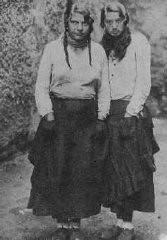
-
Portrait of two schoolchildren, Solomon Faradji and Sami Levi
PhotoPortrait of two schoolchildren: Solomon Faradji, son of Avram Faradji, and Sami Levi, son of Rafael Levi. Solomon lived at Karagoryeva 113, and Sami lived at Karagoryeva 105, in Bitola. This photograph was one of the individual and family portraits of members of the Jewish community of Bitola, Macedonia, used by Bulgarian occupation authorities to register the Jewish population prior to its deportation in March 1943.
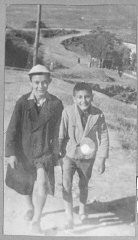
-
Portrait of Victoria and Isak Assael
PhotoPortrait of Victoria and Isak Assael, the daughter and son of Shabetai Assael. They were students and lived at Sremska 9 in Bitola. This photograph was one of the individual and family portraits of members of the Jewish community of Bitola, Macedonia, used by Bulgarian occupation authorities to register the Jewish population prior to its deportation in March 1943.
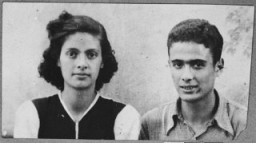
-
Portrait of Vida Kalderon
PhotoPortrait of Vida Kalderon, wife of Yakov Kalderon. She lived at Orisarska 2 in Bitola. This photograph was one of the individual and family portraits of members of the Jewish community of Bitola, Macedonia, used by Bulgarian occupation authorities to register the Jewish population prior to its deportation in March 1943.

-
Portrait of Walter Marx and his family
PhotoWalter Marx (standing at left) with father Ludwig, mother Johanna, and cousin Werner. In 1944, Walter joined partisans in Italy. He was the only one in the photograph to survive the Holocaust.
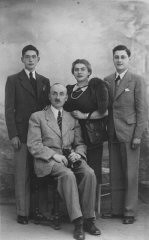
-
Portrait of writer Sigrid Undset
PhotoPortrait of writer Sigrid Undset, who won the Nobel Prize for Literature in 1928. Often with feminist themes, her novels were banned and burned in part because of her public criticism of the Nazi regime. Photo taken by Anders Beer Wilse on July 1, 1923.
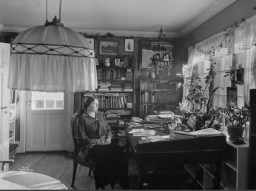
-
Portrait of Yakov Testa with his wife and three children
PhotoPortrait of Yakov Testa with wife and three children in Bitola. This photograph was one of the individual and family portraits of members of the Jewish community of Bitola, Macedonia, used by Bulgarian occupation authorities to register the Jewish population prior to its deportation in March 1943.
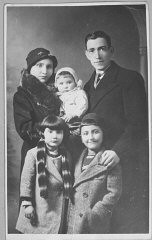
-
Portrait of Yosef Eschkenasi and his wife, Sara
PhotoPortrait of Yosef Eschkenasi and his wife, Sara. Yosef was a laborer. They lived at Zmayeva 10 in Bitola. This photograph was one of the individual and family portraits of members of the Jewish community of Bitola, Macedonia, used by Bulgarian occupation authorities to register the Jewish population prior to its deportation in March 1943.

-
Portrait of Żegota co-founder Władysław Bartoszewski
PhotoPortrait of Władysław Bartoszewski, Poland, unknown date. Władysław Bartoszewski (1922–2015) was a co-founder and member of the Council for Aid to Jews, codenamed “Żegota.” Żegota was a clandestine rescue organization of Poles and Jews in German-occupied Poland. Supported by the Polish government-in-exile, Żegota coordinated efforts to save Jews from Nazi persecution and murder. It operated from 1942 to 1945. After World War II broke out in September 1939, Władysław worked as a janitor…
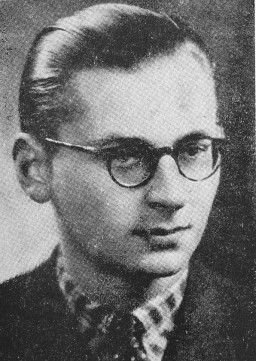
-
Portrait of Żegota member Andrzej Klimowicz
PhotoWartime portrait of Andrzej Klimowicz, Poland. Andrzej Klimowicz (1918–1996) aided and rescued Jews in Warsaw throughout the duration of the German occupation of Poland. He eventually became a member of the Council for Aid to Jews (codenamed “Żegota”), a clandestine organization that coordinated efforts to save Jews from Nazi persecution and murder. Under the auspices of Żegota, Andrzej played a role in providing Jews in Warsaw with forged identity papers and hiding places outside the walls of the…
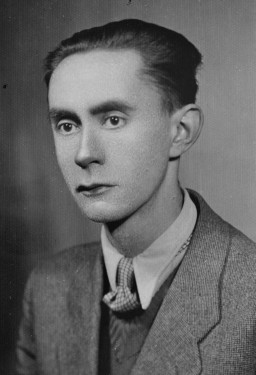
-
Portrait of Żegota member Irena Sendler
PhotoPortrait of Irena Sendler in Warsaw, Poland, circa 1939. Irena Sendler (1910–2008) was a member of the Council for Aid to Jews, codenamed “Żegota.” Żegota was a clandestine rescue organization of Poles and Jews in German-occupied Poland. Supported by the Polish government-in-exile, Żegota coordinated efforts to save Jews from Nazi persecution and murder. It operated from 1942 to 1945. Irena Sendler (Sendlerowa) was working as a social worker in Warsaw when World War II broke out in 1939. After…
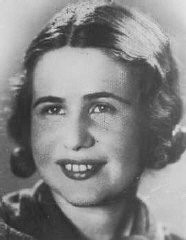
-
Portraits of Martha and Waitstill Sharp
PhotoPortraits of Martha and Waitstill Sharp from an unknown newspaper. Published before they left for Europe on a relief mission with the Unitarian Service Committee.
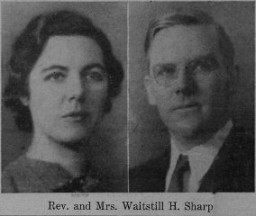
-
Portraits of Zionist leaders hang in a classroom
PhotoLyrics to the Jewish national anthem and portraits of Zionist leaders hang in a classroom in a displaced persons camp. Feldafing, Germany, after April 1945.

-
Postcard of Evian-les-Bains
PhotoPeriod postcard of Evian-les-Bains, the site of the 1938 International Conference on Refugees.
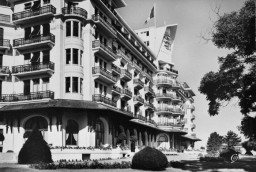
-
Postcard of the SS St. Louis
PhotoA postcard of the SS St. Louis. May 1939. The plight of German-Jewish refugees, persecuted at home and unwanted abroad, is illustrated by the May 13, 1939, voyage of the SS St. Louis.

-
Poster advertising the antisemitic propaganda film "Der ewige Jude"
PhotoA poster advertising the antisemitic propaganda film "Der ewige Jude" (The Eternal Jew) hangs on the side of a Dutch building. Amsterdam, The Netherlands, 1942.
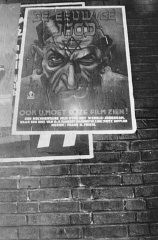
-
Poster calling for a boycott of German goods
PhotoPoster calling for a boycott of German goods. Issued by the Jewish War Veterans of the United States. New York, United States, between 1937 and 1939.
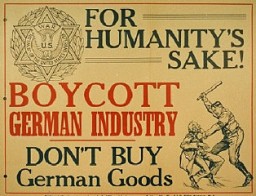
-
Poster for Nazi Party speech on Jewish Bolshevik threat
PhotoPoster for a meeting and speech about the Jewish Bolshevik threat against Germany sponsored by the local Nazi Party of East Hannover. Depicted is a silhouetted caricature of a Jewish man’s head in left profile, with a large, red Star of David beside him. The announcement at the top of the poster reads: "Victory over Bolshevism and plutocracy means being freed from the Jewish parasite!" Created ca. 1937–1940.
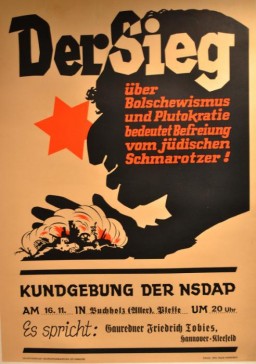
-
Poster for the antisemitic museum exhibition Der ewige Jude
PhotoPoster for the antisemitic museum exhibition Der ewige Jude (The Eternal Jew) characterizes Jews as Marxists, moneylenders, and enslavers. Munich, Germany, November 8, 1937. Nazi propagandists also created a film of the same name.

-
Poster in Hebrew for army recruitment and rescue efforts
PhotoA poster in Hebrew soliciting contributions from members of the Yishuv (the Jewish community of Palestine) for army recruitment and for efforts to rescue European Jewry. The Hebrew text reads "Give a hand in rescue, the Fund for Recruitment and Rescue." Palestine, July 22, 1943.
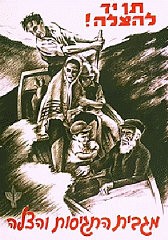
-
Poster: Nuremberg / Guilty!
PhotoPoster: Nuremberg / Guilty! After the end of the war and the defeat of Nazi Germany, Allied occupation authorities in Germany used posters such as this one to emphasize the criminal nature of the Nazi regime.
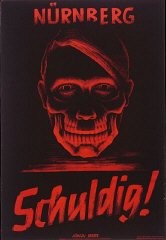
-
Poster promoting the Nazi monthly publication Neues Volk
PhotoPoster promoting the Nazi monthly publication Neues Volk. Jews were not the only group excluded from the vision of the "national community." The Nazi regime also singled out people with intellectual and physical disabilities. In this poster, the caption reads: "This hereditarily ill person will cost our national community 60,000 Reichmarks over the course of his lifetime. Citizen, this is your money." This publication, put out by the Nazi Party's Race Office, emphasized the burden placed on society by…
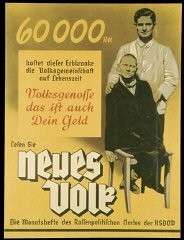
-
Poster: "Students/Be the Führer's propagandists"
PhotoPoster: "Students/Be the Führer's propagandists." With militant appeals to nationalism, freedom, and self-sacrifice, the Nazi Party successfully recruited students disenchanted with German democracy and their current student organizations.

-
Poster: "We Women Are Voting Slate 2 National Socialists."
PhotoPoster: "We Women Are Voting Slate 2 National Socialists." German women were an important voting bloc. The Nazis made a concerted effort to appeal to women, as exemplified by this 1932 election poster. The Nazis had to repackage their messages to de-emphasize military aims. Hitler consciously modeled some Nazi propaganda appeals to German women on speeches delivered by Benito Mussolini in Fascist Italy, who also had to calm the fears of Italian war widows after World War I. Nazi propagandists attempted to…
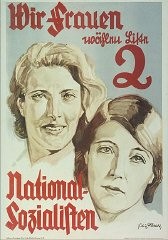
-
Postwar photo of a church in the village of Chelmno
PhotoPostwar photo of a church in the village of Chelmno. Jews were kept in this building en route to the Chelmno killing center. Chelmno, Poland, June 1945.

-
Postwar portrait of Alexander Bielski
PhotoPostwar portrait of Alexander Bielski, a founding member of the Bielski partisan group. 1945–48.

-
Postwar portrait of Piotr Kolenda
PhotoPostwar portrait of Piotr Kolenda. He was a landowner from Nowogrodek who knew both the Dzienciolski and Bielski families before the war. During the war he helped hide the women before they could safely go to the forest and continued to assist members of the Bielski group while they were in the forest.

-
Poverty in the Warsaw ghetto
PhotoA Jewish man attempts to make a living by playing music on a gramophone, which he wheels around in an old baby carriage. Warsaw ghetto, Poland, wartime.
